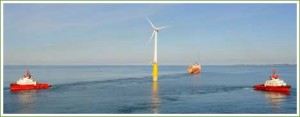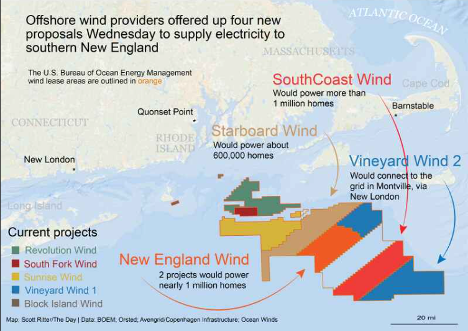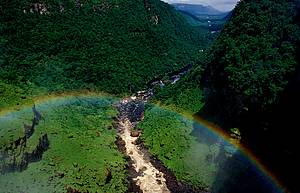World’s First Floating Wind Turbine Swtiches On

Written by Philip Proefrock on 09/21/09
The energy company Statoil has begun operation of the first full-size Hywind floating wind turbine at a location 10 kilometers off the Norwegian coast. What is remarkable about this turbine is that is is floating in the water, rather than being rigidly attached to the ocean floor.
Everyone who has paid attention to the issues of off-shore wind turbines knows that there are advantages to having constant, unobstructed winds to drive the turbines. But shorelines are prized for more than their energy potential. The numerous delays and lawsuits that sought to stop the Cape Wind project in the US show just how contentious the issue can be. But the Hywind turbine offers a new potential for offshore wind.
For a couple of years, EcoGeek been following the development of deep-water off-shore wind turbines which can avoid the largest problems typically associated with off-shore turbines. The Norwegian utility company StatoilHydro has been at the forefront of developing this with their Hywind project.
Statoil has decades of experience with operating deep sea drilling platforms for North Sea oil production, and is using that technology to support a wind turbine in deep water.
The test Hywind turbine’s location is comparable to the location of the Cape Wind offshore wind farm project on Nantucket Sound. Simulated images prepared for Cape Wind show the visual impact of 258 foot (78.6 meter) high turbines with 365 foot (111.3 meter) diameter rotors located roughly 6 miles (10 kilometers) off shore.
The difference between the two is that Cape Wind is situated in Nantucket Sound because the waters are so shallow that the turbines can be mounted to the seafloor there. The Hywind turbine, however, lies in much deeper water – able to be located in waters with a depth of 120 to 700 meters (394 to 2297 feet). The Hywind test location was kept close to shore to make the testing easier and to minimize the need for very long power cables returning to shore.
In an actual installation, Hywind turbines could be located in a large field (making up for the greater cable length with efficiencies of larger numbers of turbines) well off shore and away from scenic views as well as shipping lanes. Deepwater installations become feasible when the turbines do not need to extend all the way down to the sea floor.









